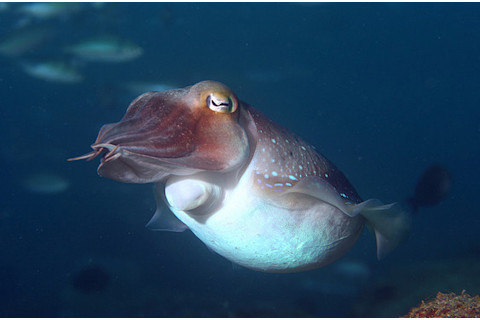
Most camouflaged creatures try to hold still so they won't give away their ruse. But cuttlefish aren't most creatures. These masters of camouflage can change color to seamlessly match their background, and they can keep swimming while they do it. "Cuttlefish are one of nature's fastest dynamic camouflagers," says Noam Josef, a graduate student at the Ben Gurion University of the Negev in Israel. The cephalopods can change color in just one tenth of a second. They can also create different patterns and textures on their skin. Despite being colorblind, they can disguise themselves as rocks, other fish, or smudges on a sandy seafloor. (Watch a cuttlefish gamely match its skin to different backgrounds in this video.) Josef wanted to know more about how cuttlefish change colors while they're in motion. So he collected eight common European cuttlefish (Sepia officinalis) from off the coast of Italy. In the lab, the palm-sized animals took turns swimming in a long, narrow tank. The floor of the tank was light gray at both ends and black in the middle. A cuttlefish swimming from one side to the other would pass over a gray background, then black, then gray again. In a control group, the tank's floor was entirely gray. Josef filmed the cuttlefish from overhead as they cruised around the experimental tank. He recorded each animal swimming in the solid gray tank, as well as making two complete passes across the black-and-gray one. Then Josef and his coauthors converted the videos to grayscale and measured how the cuttlefish had adjusted their colors while they swam. (Only one video was ruined by an animal squirting a cloud of ink.) In the gray tank, cuttlefish kept their bodies a uniform gray. In the two-toned tank, they changed color all at once as they crossed into a new area. Their bodies went from light to dark, and back again, like someone was flipping a switch. It took about a second and a half to complete the color change. Most of the time, the cuttlefish started this transition before they even reached the boundary. They seemed to be looking ahead and anticipating the color change in their environment. https://youtu.be/sE-DYSaM8Xw?t=28s "We were a bit surprised to see these results," Josef says. He had thought the animals might adjust their camouflage more gradually as they swam across the different backgrounds. Cuttlefish are capable of a swipe-like change, Josef says, so why don't they shift colors from front to back as they pass over a boundary? Changing their whole bodies at once can leave the animals momentarily exposed. Yet the researchers point out that a stark background change, like the one in their experimental tank, is rare in the wild. A cuttlefish in the ocean is more likely to cross between two areas that blend into each other—a sandy area becoming a rocky one, say. In this case its camouflage method might look better than it does in the lab. From the point of view of an ocean predator, Josef says, the cuttlefish's technique "is more subtle and probably attracts less unwanted attention." Although octopuses may have a similar skill, this is the first time scientists have recorded an animal changing its camouflage while in motion. In other words, for most animals it's true that "you can run but you can't hide." But a cuttlefish would respond to that taunt by simply vanishing.
Image: by Klaus Stiefel (via Flickr)
Josef N, Berenshtein I, Fiorito G, Sykes AV, & Shashar N (2015). Camouflage during movement in the European cuttlefish (Sepia officinalis). The Journal of experimental biology PMID: 26385328













